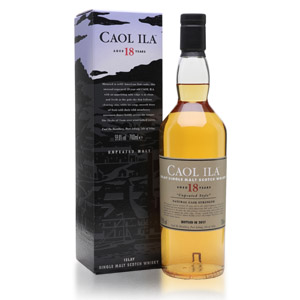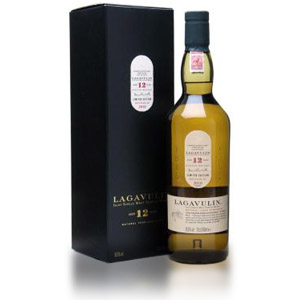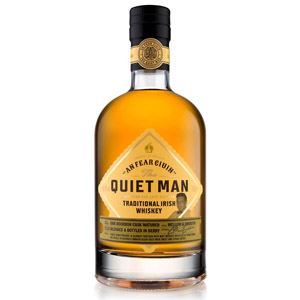I don’t get to drink a lot of Caol Ila. To me, it sits in an awkward place in the scotch whiskey pantheon: not as heavily or intensely peated as its neighbors Laphroaig or Ardbeg, and used in higher proportion than other peated malts for various blends (especially the Diageo blends), it feels like the “middle child” of the Islay drams. When I’m in the mood for peat, I usually don’t feel like going halfway and I turn to something intense like Ardbeg Corryvreckan or Lagavulin 16 or Laphroaig 10. Caol Ila just doesn’t spring to mind.
Luckily for me a longtime reader of this blog, Jamie, offered to send me a sample of his newly-acquired Caol Ila Unpeated 18-year. I’m always up for a chance to try something new without having to purchase a whole bottle! The “Unpeated Style” releases, from an annual run of unpeated Caol Ila made by the distillery for blending purposes, are a Special Release series bottled by Diageo once a year, often at different ages and always at natural cask strength. The 2017 release is the oldest bottled to date, at 18 years in (ex-bourbon) refill American oak hogsheads. There is no added color and the whisky was not chill-filtered.
I find this kind of expression to be a valuable learning opportunity: if you remove a familiar aspect (the peat) from a familiar dram, tasting the differences teaches the mind and the tongue how to identify and appreciate those aspects and allows one to understand how that flavor fits into the whole. You can also sometimes uncover beautiful notes that were otherwise masked by (in this case) the peat. (Here’s a review of the regular peated Caol Ila 18 year.)
Nose: A flurry of fruit (tropical in nature: mango, kiwi, passion fruit), which settles after a rest in the glass into a sedate lemon-lime affair flecked with vanilla and a well-rounded custardy sweetness. A twinge of smoke – not peat! – and delicate florals add interest. Despite the high ABV, the nose tickle is under control.
Palate: Syrupy body. Oaky upfront, with a sultry layer of mossy (but not smoky) peat. The tongue burn is fierce and numbing, but is accompanied by a fiery note of cinnamon and stonefruit – plum? This subsides into a typical banana-and-vanilla ex-bourbon flavor profile with a pleasant earthy note like freshly-dug garden soil.
Finish: Medium-long. Faint licorice, some oaky spices (including the cinnamon), and a large helping of somewhat bitter charcoal which obscures the rest of the finish, the only mar in an otherwise excellent dram. Fades with a ghost of menthol.
With Water: A splash of water adds a tutti-frutti or bubble gum note to the aroma, and melds the fruits into a cohesive sweet dessert-like package. The water thins the body somewhat, and does very little to tame the tongue burn. I think you’d have to aggressively water it down to achieve that. The finish is a little brighter and sweeter – again with the bubble gum. I suggest at least smelling a dram at full-strength before adding any water. Progressively add small amounts of water – allowing each time to meld – until the tongue burn is acceptable to you.
Overall: Do I lose my blogger cred if I say I like this better than the peated version? Do I have any blogger cred? This has a phenomenal whirl of fruit, a bit of sweetness, a bit of smoke, and robust texture and flavor. I could wish for a little less bitterness on the finish, but the entirety is well worth the price tag (and the experiment of leaving the peat out of a peated classic). It goes well with a splash or two of water. Either way this is a contemplative, multi-layered dram which completely does not make me miss the peat.
I’m marking this as a “Must Try” to recognize its quality and to encourage any fans of Islay malts (and Caol Ila in particular) to experience what lies underneath all the smoke.


About The Distillery
Pronounced “cull-eela”, this blender’s darling (and the largest-capacity distillery on tiny Islay) only became available as an official distillery-bottled single malt in a regular lineup in 2002, although it was founded in 1846. Caol Ila was actually demolished and rebuilt by owner DCL (now known as Diageo) in 1974. Its success as a blending component and its less “in-your-face” style has won it a reputation as a “milder” peated Islay malt, although the ppm phenols of its malted barley is the same as that used by Lagavulin (both come from the maltings at Port Ellen). Something about Caol Ila’s stills (or its distillation processes) tamps down the peaty character and renders it less smokey. The distillery, which is on the eastern coast of Islay, gets its water from a loch in the hills called Loch Nam Ban. Unlike the water that flows into the southern Islay distilleries over hard quartzite hills, Loch Nam Ban’s source rises out of limestone and glacial deposits, which give the water a vibrant minerality that sets Caol Ila’s whisky apart from its southern contemporaries.








You’re welcome. Glad you liked it!
I suppose you can’t use peated barley in your stills for over four decades, and then proceed to make a whisky that doesn’t have any notes of smoke at all. I agree that this is an excellent dram, and a phenomenal value considering it’s age. I’m going to keep a closer eye on the Diageo special releases from now on.
They’ve announced a Talisker 8 year-old for 2018….
It’s also possible that the process water (a stream that runs from Loch nam Ban) picks up some peat before reaching the distillery, and despite being cask-strength the whisky may retain some of those elements from the water in the mash. It’s also (I suppose) possible that vapors from peated casks maturing nearby impose some effect on the unpeated casks, although I’ve never read of that happening elsewhere. Thanks for the sample, again. Cheers!
Isn’t smoke (without peat) usually the result of charred casks?
Possibly, although all oak casks are charred to some degree (some more than others), and you tend to get less of that effect if the casks are not re-charred before being refilled (this was a refill cask). Personally, I think those charred-oak notes come across in caramelized sugars (caramel, butterscotch, etc.) on the palate and in a distinct sometimes-bitter charcoal flavor on the finish. It reminds me of times I’ve accidentally gotten charcoal dust in my mouth while pouring out a bag of charcoal for the grill. It’s definitely possible that “smoke” notes are also a result. Cheers!
Peat flavor comes from combustion of peat, not water. Some batches of this unpeated Caol Ila have distinct hints of peat smoke, other batches seem clear of this, at least to my taste. The reason for this, it seems to me, would be the difficulty of completely cleaning a distillery before the unpeated run. Think of all the pipes, tanks, etc. Now think of how hard it is to get smoke smell out of things. I amazes me they are able to clean it as well as they do.
Peat does have a small influence due to the process water used on Islay distilleries…technically most of Bunnahabhain’s core releases classify as “unpeated” since they don’t use it during the malt drying process; however, there is still a 2-3ppm phenol content that comes from the water itself. I think the unpeated Bruichladdich releases encounter the same situation? Now you’d need a pretty sophisticated palate to pick it out vs. the typical 30-50 ppm phenol levels seen in Laphroaig/Ardbeg/Lagavulin, but it is there.
Funny thing is, I originally bought this bottle online from my preferred spirits retailer, but I returned it once I got to the store and realized it was unpeated malt. So glad I later reconsidered that decision…I would have missed out on one of the great drams of my life so far.
Here’s a pretty informative article discussing the production processes at Caol Ila, including how they manage to get a very different flavor profile from Lagavulin in spite of using identical malt. It also says that the unpeated stuff is no longer being produced(!). If true, that would go a long way toward explaining the advanced ages and limited availability of recent bottlings.
http://www.drinkspirits.com/scotch-whisky/behind-the-scenes-caol-ila-islay-whisky/
In my favorite Richmond VA whisky bar I was able to line up the CI 18 with the 2013 Stitchell’s Reserve (named for former CI distillery manager Billy Stitchell), also unpeated and cask strength and rumored to be of similar age. I found SR to be much more flavorful and distinctive vs the 18. Both can be found for $100 so if you’re a CI fan like me, it’s an expression to keep an eye out for. (That said, the best CIs are independent bottlings. Often the younger the better)
[…] of a bottle of Caol Ila 18 year (purchased in 2019). I was very happy with his previous sample, an Unpeated Caol Ila 18 from 2017, so we both thought it would be interesting to see how the “standard” peated 18-year […]